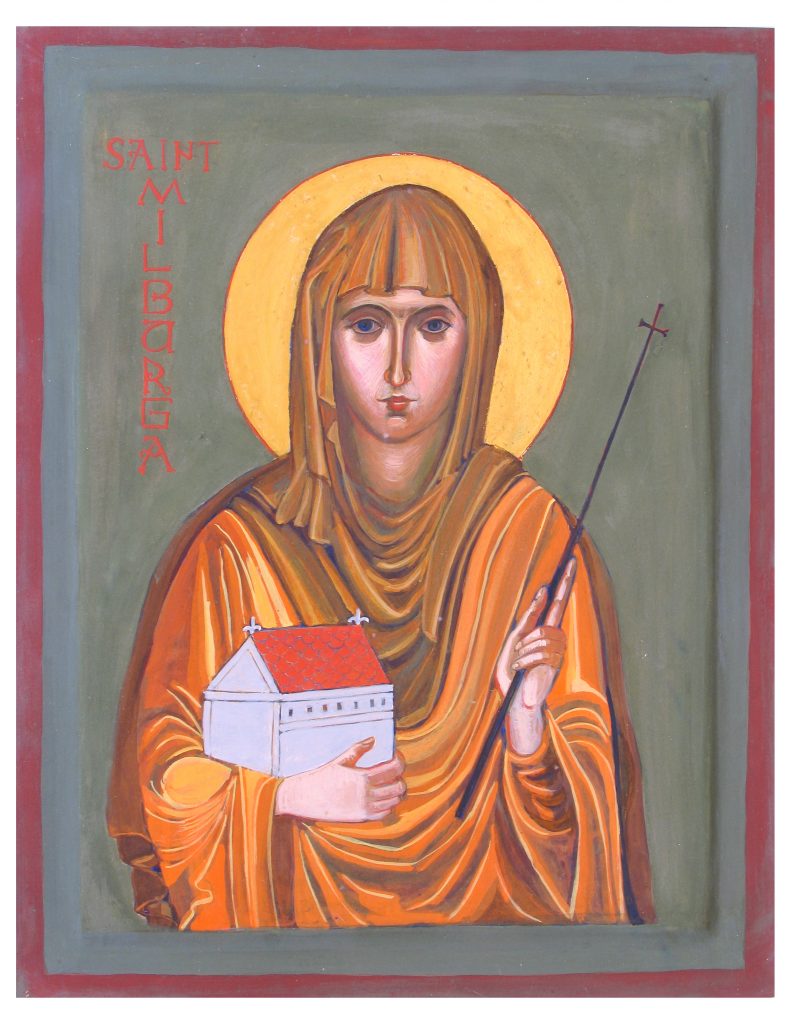


Milburga was a mid–seventh century Benedictine abbess who served the monastic community of Wimnicas–modern day Wenlock Priory–in Magonsaete. This monastery, founded around 670, was unique as both nuns and monks lived here, and a woman managed both the women and men. Consequently, when Milburga became the abbess around 680, she gave spiritual guidance to women and men alike.
Beth Allison Barr argues that in her medieval context, an abbess exercised more authority than a pastor of a local church today. Artwork of her portrays her with a crozier, an item often connected to bishops. Furthermore, abbesses and abbots during this time performed the tasks that were set apart only for priests beginning in the twelfth century, such as baptisms, preaching, and observing confession. Barr further explains that the term bishop suits Milburga because she did not simply perform her duties for women, but men and women alike. Secondly, in the early medieval context, bishops were likened to abbots and abbesses. That Theodore, the archbishop of Canterbury, ordained Milburga illuminates her dignified role as an abbess.
Milburga was not an oddity of the medieval church. Indeed, she and women alike served in these leadership positions. Though venerated as a saint not long after her death around 715, many do not know the details of Milburga’s leadership, perhaps because historians have spent more time telling of the men who came after her. Regardless, history cannot erase her: the abbess with the crozier teaches us of women’s powerful leadership in the medieval church.
Sources:
Barr, Beth Allison. Becoming the Pastor’s Wife: How Marriage Replaced Ordination as a Women’s Path to Ministry, Grand Rapid: Brazos Press, 2025.
Beth Allison Barr argues that in her medieval context, an abbess exercised more authority than a pastor of a local church today. Artwork of her portrays her with a crozier, an item often connected to bishops. Furthermore, abbesses and abbots during this time performed the tasks that were set apart only for priests beginning in the twelfth century, such as baptisms, preaching, and observing confession. Barr further explains that the term bishop suits Milburga because she did not simply perform her duties for women, but men and women alike. Secondly, in the early medieval context, bishops were likened to abbots and abbesses. That Theodore, the archbishop of Canterbury, ordained Milburga illuminates her dignified role as an abbess.
Milburga was not an oddity of the medieval church. Indeed, she and women alike served in these leadership positions. Though venerated as a saint not long after her death around 715, many do not know the details of Milburga’s leadership, perhaps because historians have spent more time telling of the men who came after her. Regardless, history cannot erase her: the abbess with the crozier teaches us of women’s powerful leadership in the medieval church.
Sources:
Barr, Beth Allison. Becoming the Pastor’s Wife: How Marriage Replaced Ordination as a Women’s Path to Ministry, Grand Rapid: Brazos Press, 2025.
Title of Art: Milburga
Subjects: Milburga
Ritual Pose/Object: monastery
Art Form: Painting
Exhibit Institution: Church of the 318 Holy Fathers
Exhibit Location: Shrewsbury, United Kingdom
VM Image #: 0122
